Types of Axles
Following are the three different types of axles
- Rear Axles
- Front Axle
- Stub Axle
Rear Axle
In between the differential and the driving wheels is the rear axle to transmit power from the differential to the driving wheels. It is clear from the construction of the differential, that the rear axle is not a single piece, but it is in two halves connected by the differential, one part is known as the half shaft.
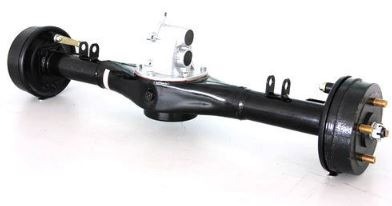
The inner end of the half shaft is connected to the sun gear of the differential. and the outer end of the driving wheel. In rear-wheel-drive vehicles, the rear wheels are the driving wheels. Whereas, in front-wheel drive vehicles, the front wheels are the driving wheels. Almost all rear axles on modern passenger cars are live axles, that is, they revolve with the wheels.
Dead axles simply remain stationary, do not move with the wheels. A housing completely encloses the rear axles and the differential, protecting them from water, dust and injury, in addition to mounting their inner bearings and providing a container of the lubricant.
Read also: What is a steering system? and how it works? [The complete guide]
Types of Rear axles
Depending upon the methods of supporting the rear axles and mounting the rear wheels, the three types of rear axles are as follows:
- Semi-floating axle
- Full-floating axle
- Three quarter floating axle
Semi-Floating Axle
A semi-floating axle has a bearing located on the axle and inside the axle casing. It has to support all the loads as listed above. Therefore, it needs to be of a larger size, for the same torque output, than any other type. The inner end of the axle is supported by the differential side gear.
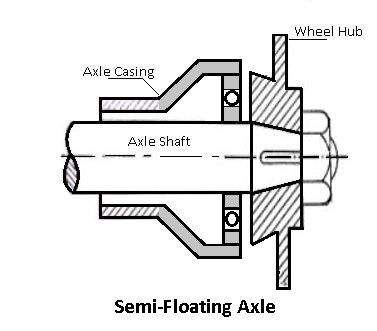
It is thus relieved of the job of carrying the weight of the car by the axle housing. The outer end has to support the weight of the car and take end thrust. The inner end of the axle is splined to the differential side gear.
The outer end is flanged so that the wheel can be bolted directly to it. In some design, the hub of the wheel is keyed to the outer end of the axle. The vehicle load is transmitted to the axle through the casing and the bearing, which causes the bending or shearing of the axle. The semi-floating axle is the simplest and cheapest of all other types and widely used on cars.
Full-Floating Axle
A full floating axle has two deep groove ball or taper roller bearings, located between the axle casing and wheel hub. The outer of an axle is made flanged to which the wheel hub is bolted. The axle is not supported by bearing at either end, and its position is maintained by the way that it is supported at both ends.
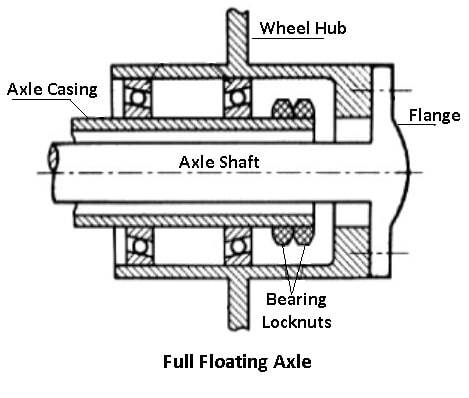
Thus the axle is relieved of all strain caused by the weight of the vehicle on the end thrust. It transmits only the driving torque. For this reason, it is called full floating. The axle may be removed from the housing without distributing the wheel by removing the nuts.
An additional advantage of this design is the ability to the vehicle even if it has a broken axle. This type of axle is more, expensive and heavier than the other axle. It is usually fitted on commercial vehicles.
Three-Quarter Floating Axle
This type of axle has a bearing placed between the hub and the axle casing. Thus, the weight of the vehicle is transferred to the axle casing, and only the side thrust and driving torque are taken by the axle.
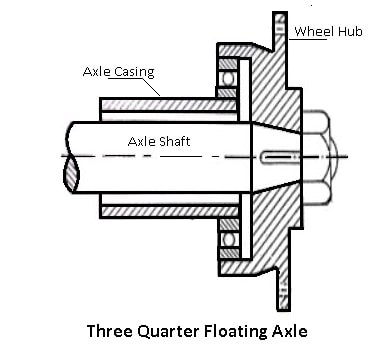
The axle is keyed rigidly to the hub, thus proving the driving connection and maintaining the alignment of the wheel. The inner end of this axle has the same construction as that of the semi-floating axle. Although the three-quarter floating axle is more reliable it is not as simple as the semi-floating axle.
Read Also on Our Blog: 4 Different Types of Gearbox That Are Used In Modern Vehicles
Front Axle
The front axle is used to carry the weight of the front part of the vehicle as well as to facilitate steering and absorb shocks due to road surface variations. It must be right and robust in construction.
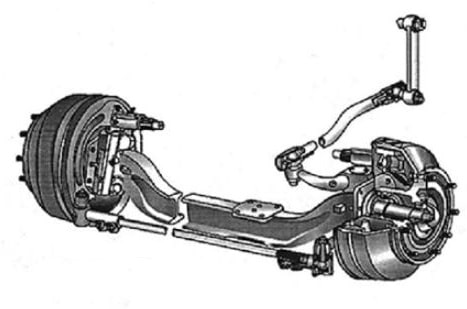
The front axle is usually a steel drop forging having 0.4% carbon steel or 1-3% nickel steel. It is made of I-section in the centre portion, while the ends are made either circular or elliptical.
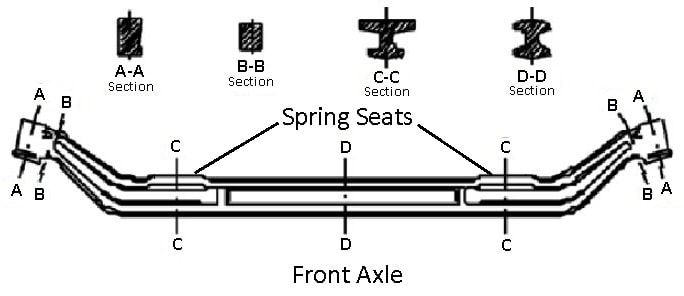
With this construction, it takes bending loads due to the load of the vehicle. Also, the torque centre portion is given a downward sweep. The different components of the front axle are the beam, stub axle, swivel pin and track rod.
Read also: Basic Engine Components (Engine parts Names and Pictures)
Types of Front Axles
Usually, there are two main types of the front axle:
- Live front axle.
- Dead front axle.
The front axles are usually dead axles because they do not rotate, in contrast to the live axles that they are used in the rear axle to transmit power to the rear wheels. A live front axle, as compared to the dead axle, has the additional function of transmitting the driving power taken from a transfer gearbox to the front wheels having a different swivelling mechanism.
The live front axles although resembling the gear axles have some difference at the axle half shafts end where the wheels are mounted. A dead front axle has enough rigidity and strength to carry the weight of the vehicle from the springs to the front wheels.
The ends of the axle beam are formed suitably to assemble the stub axle. In order to accommodate a swivel pin connecting the sub axle portion of the assembly, the ends of the beam are usually shaped either as a yoke or plain surface with drilled hole.
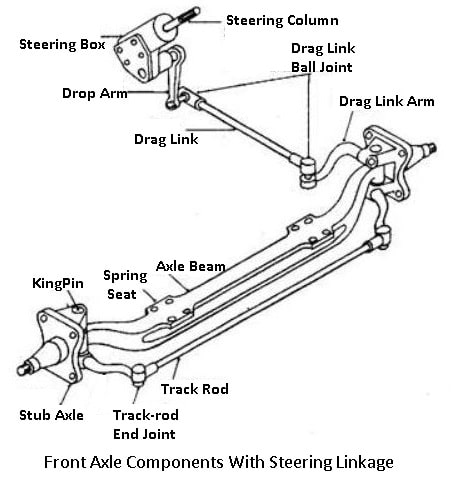
The figure shows front axle components with the steering linkage. The wheels are fixed on the stub axles which are usually pivoted. From the stub axle, the inclined steering arms are connected to the track rod ends, and a third steering arm is attached to the drag link.
Some vehicles have the drag link placed transversely instead of in the fore and at the position in order to allow a more compact vehicle design. It is often used in independent wheel suspension systems. The drag link connects the steering linkage to the drop arm of the steering box.
Stub Axle
The front wheels are mounted on the stub axles, which are connected to the front axle by means of kingpins. The stub axles are the foreging of 3% nickel steel and alloy steels containing chromium and molybdenum.
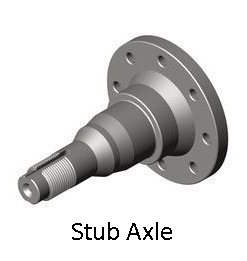
The stub axle turns on the pink pin which is a light drive fit in the axle beam eye placed and locked by a taper cotter pin. Phosphor bronze bushes are fitted into the forked ends of the axle to provide a bearing surface for the kingpin.
Vertical load are taken by a steel washer or a thrust bearing located either on the top fork of the stub axle or between the lower fork and the underside of the axle beam.
Types of Stub Axle
Following are the four types of the stub axle:
- Elliot.
- Reverse Elliot.
- Lamoine.
- Reversed Lamoine.
The Elliot stub axle is attached to the front axle by placing in the yoke end with a kingpin and cotter to join the two together.
In Reversed Elliot type stub axle, the arrangement is reversed. In Lamoine type stub axle, instead of yoke type hinge, an L-shaped spindle is used as shown in the figure.
Download Pdf of this article
That’s It, Thanks for reading if you like this article on Types of Axles please share with your friends. Have any questions to ask leave a comment.
Read Next: Four Wheel Steering System
Image source: Indiamart.com
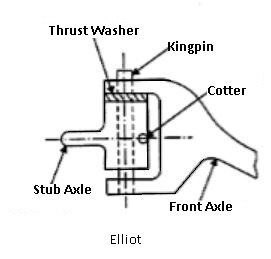
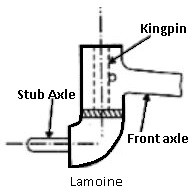
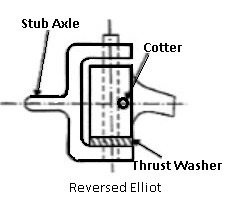
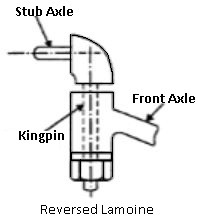

Good technical information. Where can I get the information about differentials in automotive
Thanks for your feedback.
Brilliant! Very explanatory. Thank you Saif
You’re welcome.
Good
Thanks
Awesome
Thanks
♥.♥